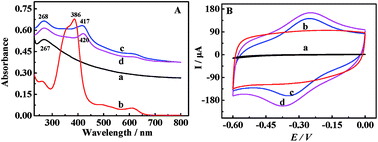An ultrasensitive electrochemiluminescent d-alanine biosensor based on the synergetic catalysis of a hemin-functionalized composite and gold–platinum nanowires
Abstract
Herein, an ultrasensitive and stereo-selective electrochemiluminescent (ECL) biosensor based on ECL signal amplification of luminol by the synergetic catalysis of a hemin-functionalized composite and gold–platinum nanowires (Au-PtNWs) has been designed for the detection of D-alanine (D-Ala). In the sensor design, D-amino acid oxidase (DAAO) was used to generate the ECL co-reactant (H2O2) for luminol in situ. The reduced graphene oxide-hemin-cysteine (rGO-H-Cys) composite and Au-PtNWs acted not only as amplification labels to amplify signals via synergetic catalysis, but also as an ideal nanocarrier to accelerate electron transfer. A great difference in ECL intensities toward D-Ala and L-Ala was obtained, and an obviously higher intensity was seen for D-Ala. Under optimal conditions, the ECL intensity had a linear relationship with the logarithm of the D-Ala concentration in the range from 1.0 × 10−9 to 5.0 × 10−3 M with a detection limit of 3.3 × 10−10 M (S/N = 3). This study provides a new method for the determination of D-Ala in food with high sensitivity, excellent selectivity, and good stability and reproducibility.

- This article is part of the themed collection: Analytical Methods Recent HOT articles


 Please wait while we load your content...
Please wait while we load your content...